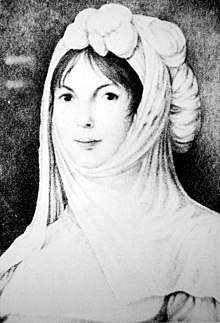Elisabeth von Staegemann
Johanna Elisabeth von Staegemann (born April 11, 1761 in Königsberg i. Pr. , † July 11, 1835 in Berlin ) was a German writer , painter and salonnière .
Life
The daughter of the Prussian merchant, Kommerzienrat Johann Jakob Fischer (lost in 1786) and Regina born. Hartung (1734–1805) grew up in the Kgl. The capital and royal seat of Königsberg in Prussia . In her liberal society, which was open to the arts and science, she already gained a reputation as a young woman. Among others, she was known to Johann Friedrich Reichardt , Immanuel Kant and Theodor Gottlieb von Hippel , Friedrich Gentz and the poet Friedrich August Staegemann were among her admirers. In 1780 she married the Justizrat Graun, son of the composer Carl Heinrich Graun . When her husband was called to Berlin in 1787 , Elisabeth stayed alone in Königsberg with her two children and her mother for eight years. Towards the end of the 1780s she established a salon-like sociability and followed her husband to Berlin in 1795, but filed for divorce at the end of the year. A year later she married the Prussian civil servant and writer Friedrich August Staegemann in Königsberg, who had already adored her in the 1780s. In 1806 she went to Berlin again with him.
Due to Prussia's defeat in the battle of Jena and Auerstedt , the Staegemanns went back to East Prussia with the royal family. Their children became playmates for the princes and princesses. Friendly ties were also established with Prince Radziwiłł and his wife Luise von Prussia . After a three-year stay in Königsberg, the family returned to Berlin in 1809/10. Salon life, which had not rested in East Prussia either, was continued and intensified. Meanwhile, wife of State Councilor, Elisabeth Staegemann soon played a leading role in Berlin's cultural life, especially since her friend Rahel Varnhagen's circle had dissolved in 1806 and left a social vacuum.
1816 with her husband ennobled , Elisabeth used to old age musical and literary gatherings in her home, where they could participate myself but since the late 1820s due to illness no more. Her daughter Hedwig von Olfers, now married, took her place as host . Since her time as a Salonnière, she has written and painted sporadically, including some self-portraits; but she saw herself as an amateur all her life. Adored by many personalities in literary and political life, including Heinrich von Kleist , she died in Berlin in 1835. Her grave is in Cemetery III of the Jerusalem and New Churches in Berlin-Kreuzberg . She rests there next to her second husband and their granddaughter Marie von Olfers .
Her husband dedicated the Memories of Elisabeth to her , a collection of sonnets he had written for her since the beginning of their relationship. After their wedding in 1796, for example, he dedicated these verses to her:
Elisabeth, I won it hotly.
Shackled early in chaste love,
I only serve you, your knight without blame.
By your choice, embraced by your arm
I will now - o let me proudly say it! -
Also equal to your soul nobility.
salon
The Salon of Elisabeth Staegemann, they since about 1810 free every day (sometimes Wednesdays) only in the Hunter Street, then called together (since 1818) in the Charlotte Street 68, on Dönhoffplatz (from 1825) and finally in the Charlotte Street 31 (since 1831), historically stands between the so-called “Rahelzeit”, ie late Enlightenment / early romanticism , and the Biedermeier period . As with many other contemporary salons, the relative freedom from class barriers in the selection of guests and their interaction with one another is sociologically significant. Her own artistic talents also gave the Salonnière special access to poetry and music, as cultivated in her house. Writers such as Kleist, Clemens Brentano and Achim von Arnim presented their works here. Numerous statesmen and military men of the Prussian reform period came and went with Elisabeth Staegemann.
family
Elisabeth Fischer married the judiciary Graun on July 26, 1780. The marriage was unhappy and divorced in 1795. Two children sprang from her:
- Ferdinand Graun , lawyer
- Antonie Theodora Graun (1785–1859) ∞ (1) 1804 Nicolaus von Schmysing gen. Korff , (2) 1815 Lieutenant Colonel Friedrich von Horn .
In September 1796 she got a second marriage with Friedrich August Staegemann (1763-1840), who was born in 1816 by King Friedrich Wilhelm III. was ennobled by Prussia . Your children were:
- August von Staegemann (1797–1866), landowner and philosopher
- Hedwig von Staegemann (1799–1891) ∞ Ignaz von Olfers
Elisabeth von Staegemann founded a Salonnièren dynasty through her daughter from her second marriage, Hedwig, which her granddaughter Marie von Olfers (1826–1924) continued. Her great-granddaughter was Sibylle von Olfers .
Works
- Memories for noble women. 2 vols. Leipzig 1858.
Well-known habitués
Individual evidence
- ^ Hans-Jürgen Mende : Lexicon of Berlin burial places . Pharus-Plan, Berlin 2018, ISBN 978-3-86514-206-1 , pp. 245, 247.
- ↑ Quotation from Wilhelmy, p. 403 f.
literature
- Margarete von Olfers: Elisabeth von Staegemann. Life picture of a German woman. 1761-1835. Köhler & Amelang, Leipzig 1937.
- Petra Wilhelmy: The Berlin Salon in the 19th Century. Walter de Gruyter, Berlin a. a. 1989.
Web links
- Literature by and about Elisabeth von Staegemann in the catalog of the German National Library
| personal data | |
|---|---|
| SURNAME | Staegemann, Elisabeth von |
| ALTERNATIVE NAMES | Staegemann, Johanna Elisabeth von (full name); Fischer, Elisabeth; Graun, Elisabeth |
| BRIEF DESCRIPTION | German writer, painter and salonnière |
| DATE OF BIRTH | April 11, 1761 |
| PLACE OF BIRTH | Koenigsberg i. Pr. |
| DATE OF DEATH | July 11, 1835 |
| Place of death | Berlin |
